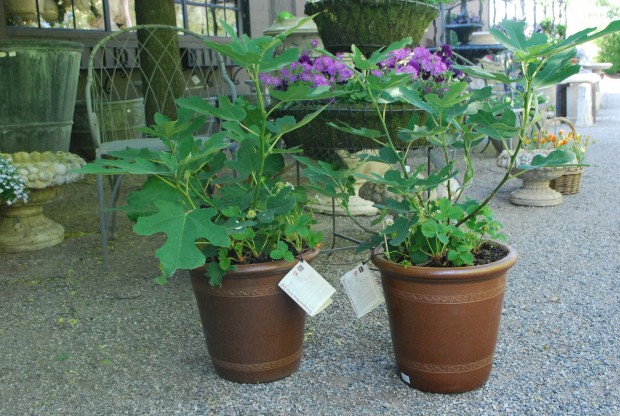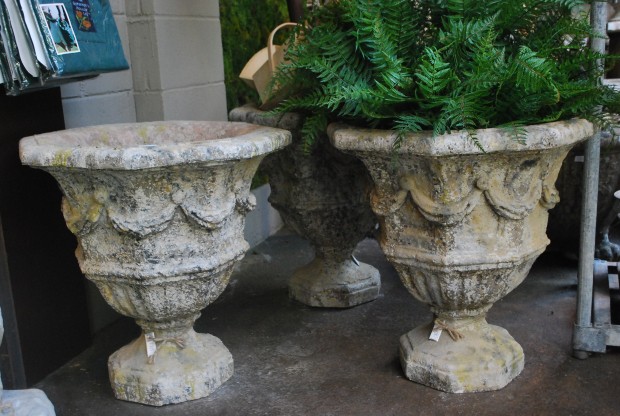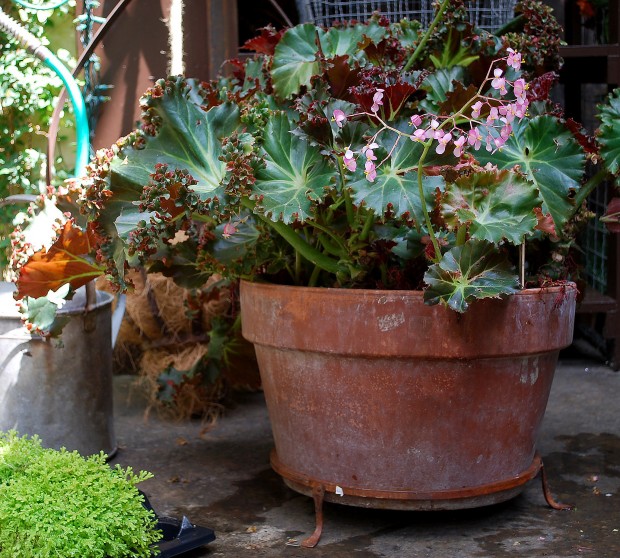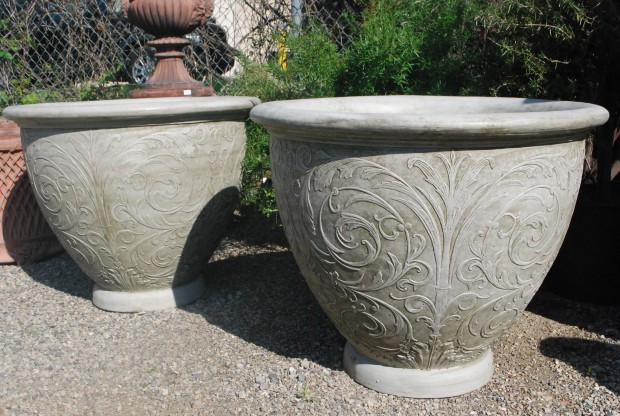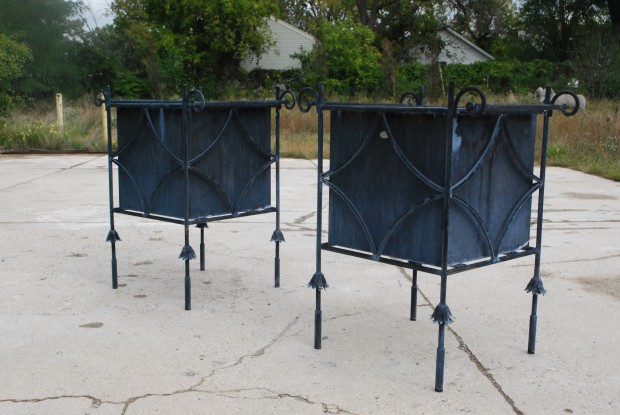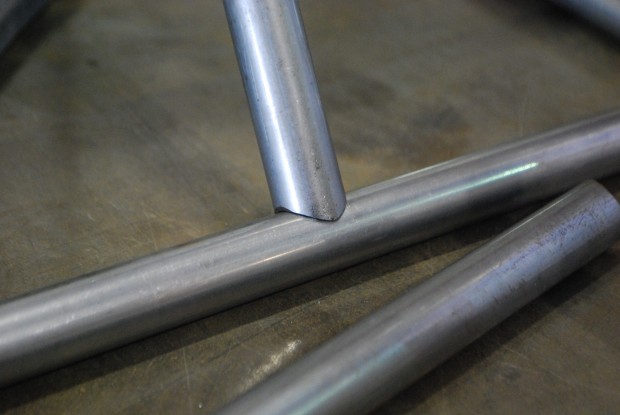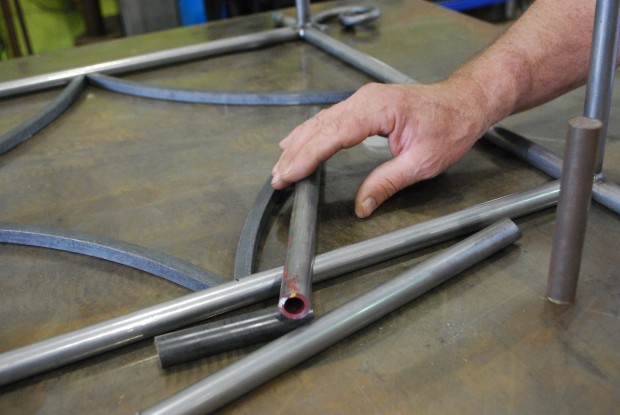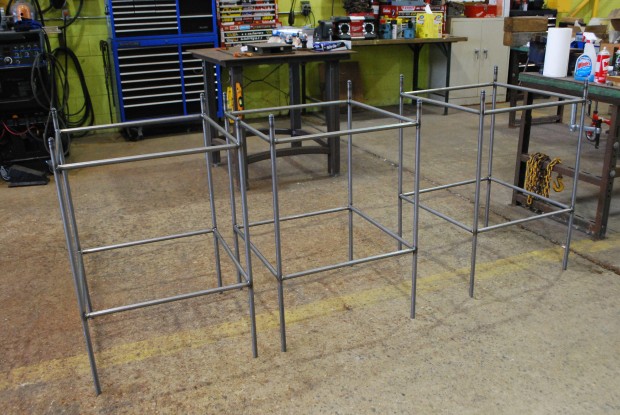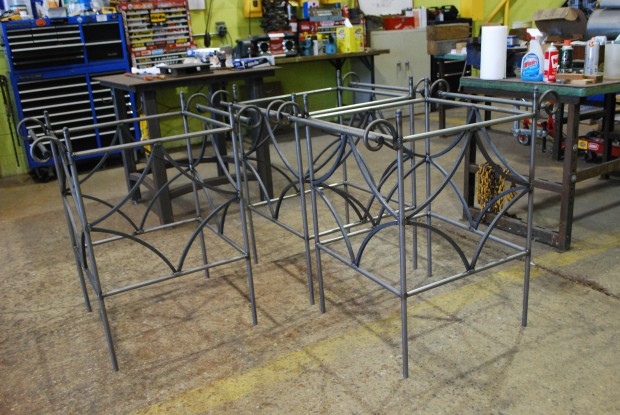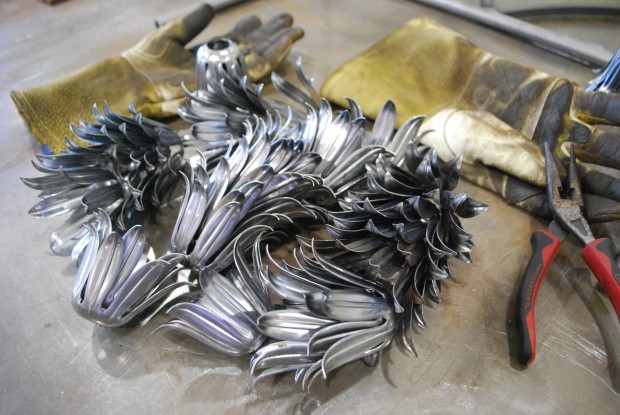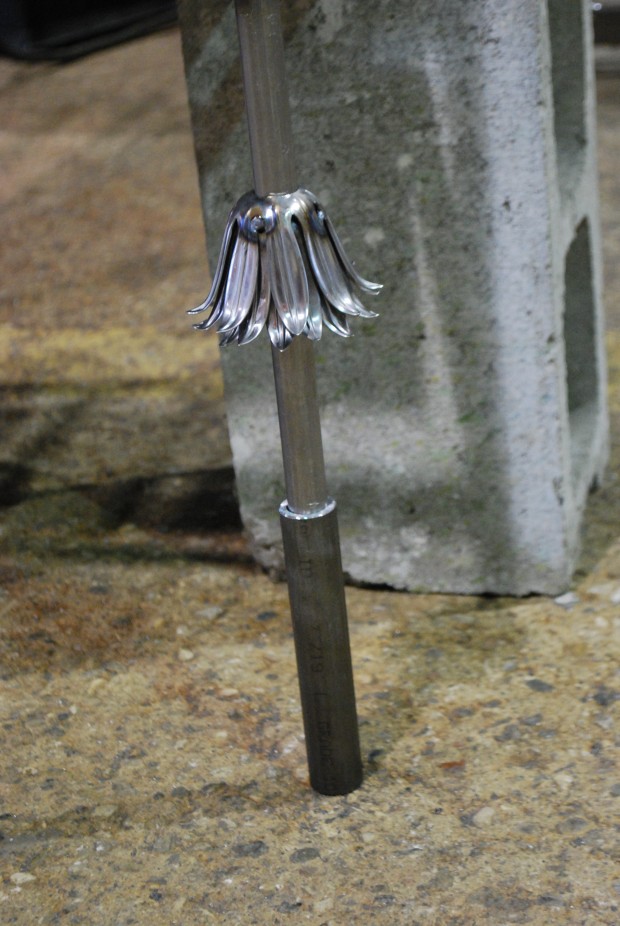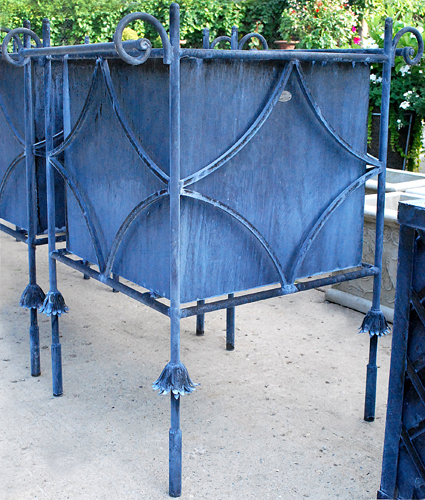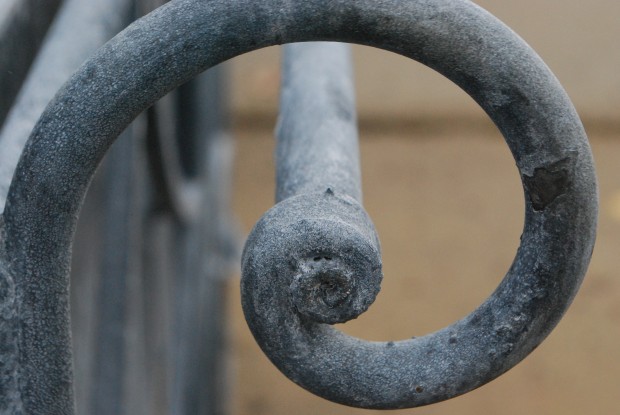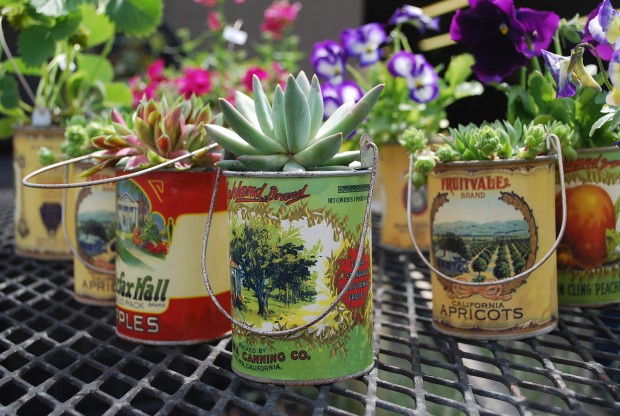
It is just about time to plant containers. Last night’s overnight temperature of 41 degrees proves that it is still spring in Michigan, but every gardener in my zone is busy planning for their summer season. More than any other time of year, gardeners who have decided they want new or more pots are popping the question-which ones? Which pots will be the best for me? These reproduction vintage tin cans are great-in the right place, and with the right material. They would need to be on a table top to be seen. Given that each one holds about 6 ounces of dirt, what gets planted in them will need to love to be dry. My first question is always-where do you want pots? And then, what do you want to grow?
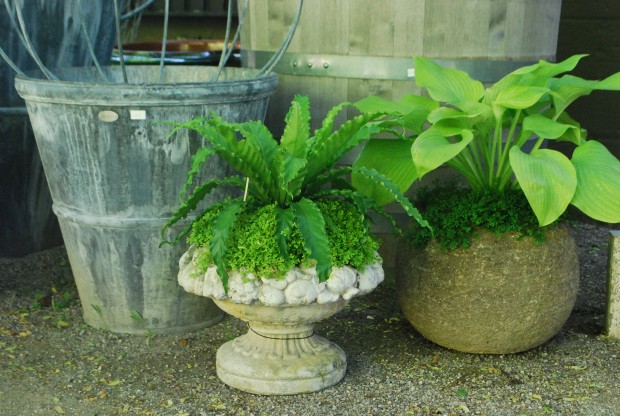
Small scale pots, such as the ones pictured above, can be placed on the ground at a front door, or on a terrace, provided they have a little grown up company. This may mean they get paired with larger pots, or sit on top of a pillar of similar scale. Small pots on their own can look lost. Small pots also benefit from a simple and strong planting, rather than a fussy one. Stone and concrete pots, with proper care, will last a lifetime. They shrug off the worst that the winter has to dish out. Natural stone has one important leg up on concrete-the little crooks and crannies are friendly to mosses and lichens. Who wouldn’t welcome a community of lichens on their pots?

This galvanized metal container is a fabulous vintage piece that Rob found in England. A brand new galvanized horse trough from a local feed store can do just as good a job providing a home for a collection of cottage style flowers as this English tub. But the aged surface, the rim and bottom detail of this tub adds a whole other dimension to the idea of growing plants in containers. The container has a beauty all its own-planted or not. Where is it a good to plant galvanized horse troughs? In a vegetable, cutting, or cottage style garden. At the front door of a vintage Arts and Crafts style house, I would go with this vintage English piece. Put special containers in important places.
English stoneware pots have a very distinctive style and surface. There is something very comforting and sturdy about them. Rob says they remind him of baked goods. Like the English galvanized round, they would look great with an Arts and Crafts house-or an informal area of a more formal English style home. They are appropriately planted with a shrubby fig, and some strawberries. These pots will always be comfortable planted with herbs, rosemary, or marguerites. With formal plantings, they might fall a little short. Which pots? Pick pots that look like they belong to you, and belong to your garden, before you decide to purchase.
I still remember a visit some 18 years ago to a very contemporary home, the terrace of which featured two very traditional, very Smith and Hawkins style, teak benches. My thought- surely contemporary garden furnishings were available to gardeners whose taste ran to the more modern? Back then, not so much. Rob shopped originally for contemporary pots in Belgium. Belgium and Michigan have very similar climates, so the simple shapes work well in a variety of settings. Many more local companies now feature modern containers. If contemporary is an architectural stylre that appeals to you, pass by those iron urns and those ornate Italian terra cotta pots. There is something better for you, out there. Should the idea of wood pots appeal to you, consider the ongoing maintenance. Wood does weather, which means it will deteriorate without regular care. Soil should never come in direct contact with wood. We recommend waterproofing the inside of the containers with Waterlox. We go even further-a sheet metal liner will keep moisture well away from the wood.
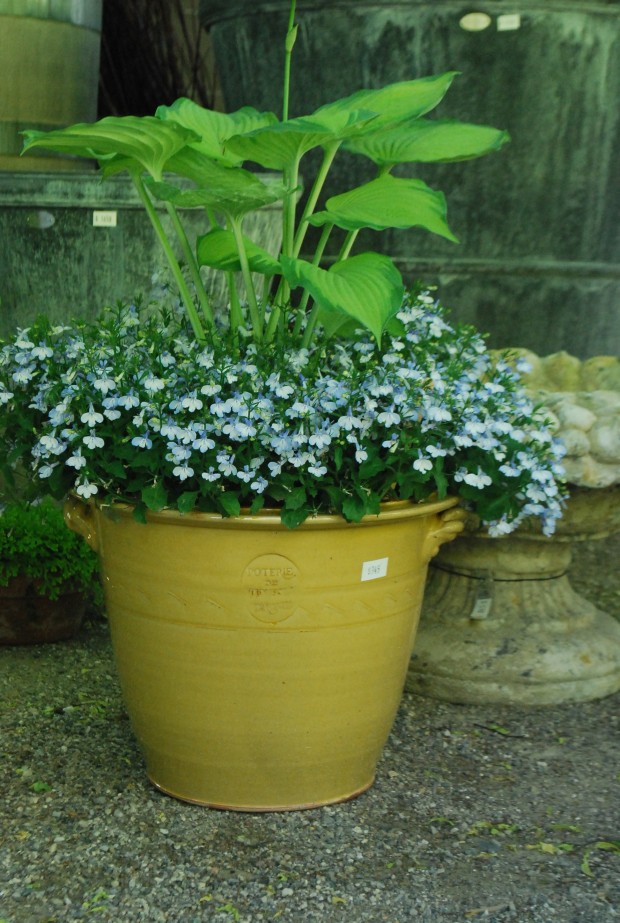
Glazed containers add an element of color to a planting that can be very pleasing. Even the smallest glazed container will attract attention, by virtue of that unexpected color. This planting in a yellow glazed French pot-vivacious, yes? A dash of color from a single small container might be just the thing to revitalize a grouping of pots.
Concrete pots that are mass produced in molds have that distinctly impersonal and too universal look. A garden is a very personal expression-is it not? If concrete is your material of choice, look for pots with distinctive finishes. These classic but rustic urns are French made. Their highly textured surfaces are beautiful.
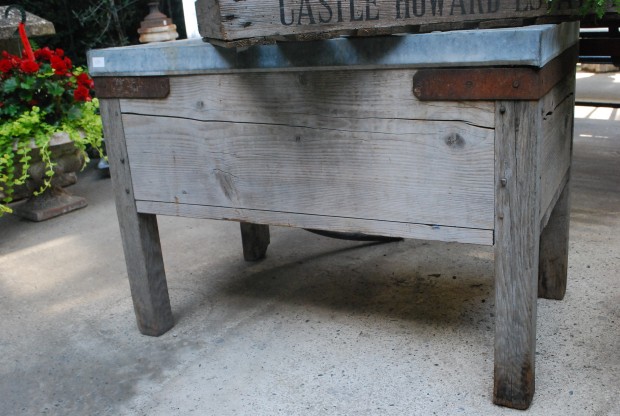
Wood boxes make great containers. They are at home in a variety of settings-from the ultra contemporary to the farm garden. This vintage wood box has an integral zinc liner. I could see it planted solid with lavender, or dahlias. I could see it with at least 10 other planting schemes. If you have a different idea for your containers every year, choose pots that roll with the moment. Some containers can move from informal to glamourous to modern-given a certain planting. Should you be an adventurous container planter, choose pots that will adapt to your current inclination.
Beautifully ornate urns-buy them with the idea that you will plant such that the shape and detail is not lost. If containers that drip with all manner of trailing plants is your thing, simple pots are the order of the day. I have always wanted to try this- planting a pair of aluminum garbage cans with holes drilled in the bottom could be great. Given a big emphasis on trailing plants. Are you game? 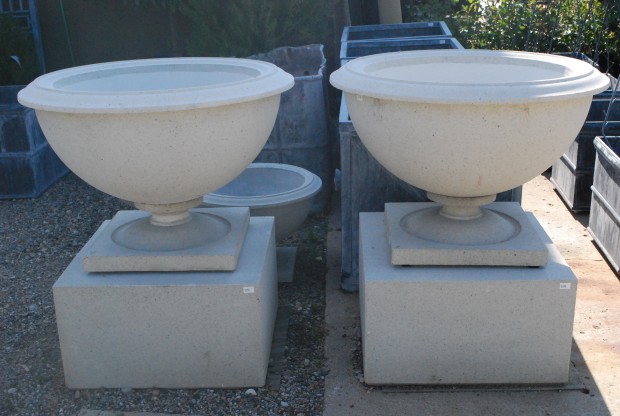
These simple footed urns are a reproduction of a Frank Lloyd Wright classic original. It comes in three sizes, from Nichols Brothers Stoneworks-we are a dealer for them. I like the massive bowl elevated off the ground by a properly proportioned foot. These pots are big enough to hold a whole summer garden. If you are a fan of green, and evergreen, in your landscape, these pots will enable a contrasting boatload of flowers. They will also distinctively represent a mass planting of rosemary. These pots are an easy pick-so versatile.
If your garage or shed is full of machine made Italian terra cotta you have had for ages, cast a fresh eye on them. Old terra cotta pots have a great surface. Lifting them off the ground in a small rusted steel stand will give them an entirely new look. Fired earth is always a great choice for pots. Maybe you do not need new pots. Rethinking the placement and display of your old pots might make you realize you already own the ones that are perfect.
New concrete can be a visually a tough material. But new concrete with a beautiful pattern, and subtle finish could provide just what you need. Looking for new pots? Consider the shape, the style, and proportion. Consider your taste in plants. Get professional help if you can. An investment in new pots only makes sense if they give you better than the look you want. Consider the detail, the finish, the architectural style, the location, the placement. Will you see your pots from the street, or sitting down on the terrace to have dinner? Find a place to get your questions answered in a way you trust. Are you in my area? Rob buys for the shop, and he has a big love for well chosen containers, and great plantings. He is just about the best I know in the “which ones” department.To contact Rob-email rob@detroitgardenworks.com. Introduce yourself. Pictures are a big plus. He is really great-you’ll see.
